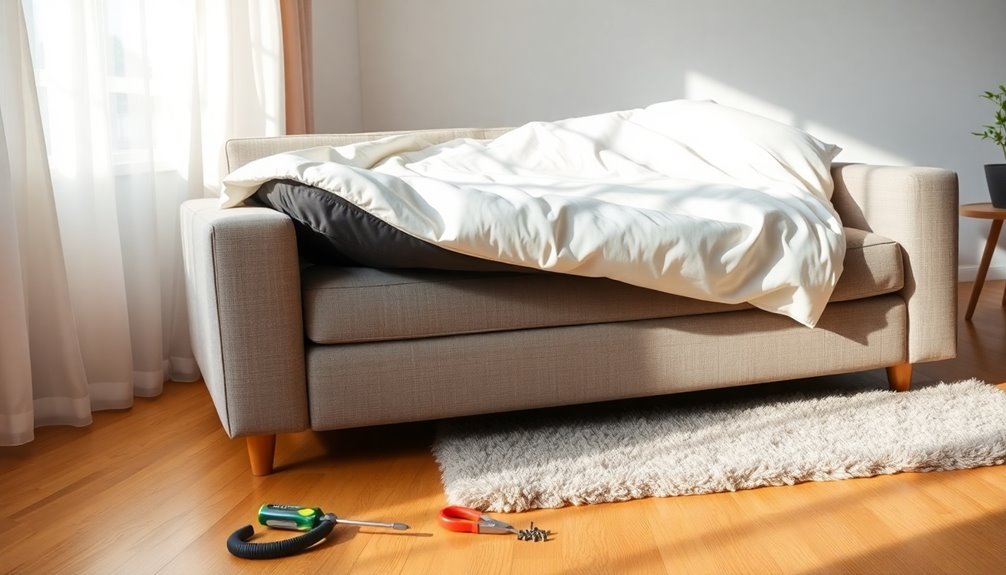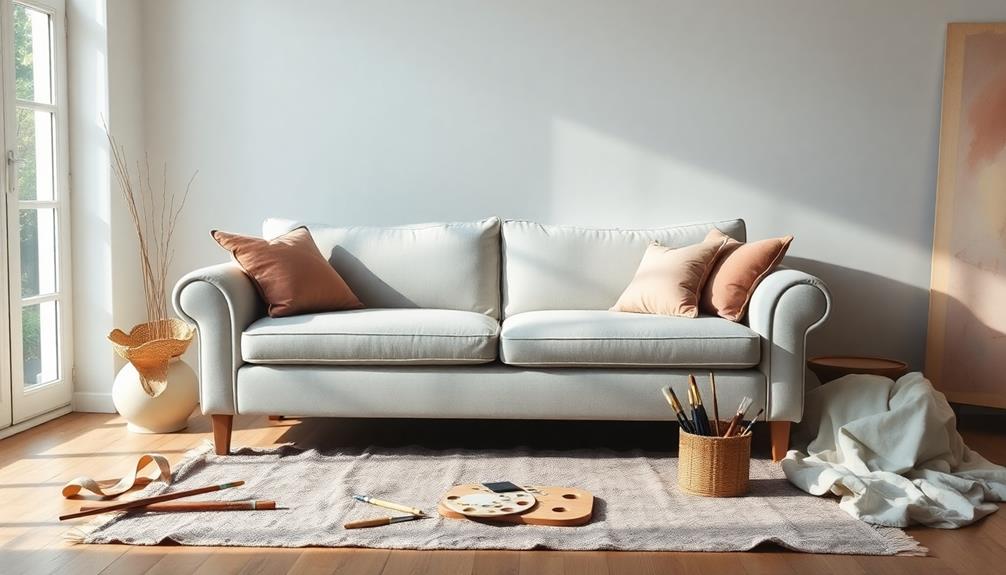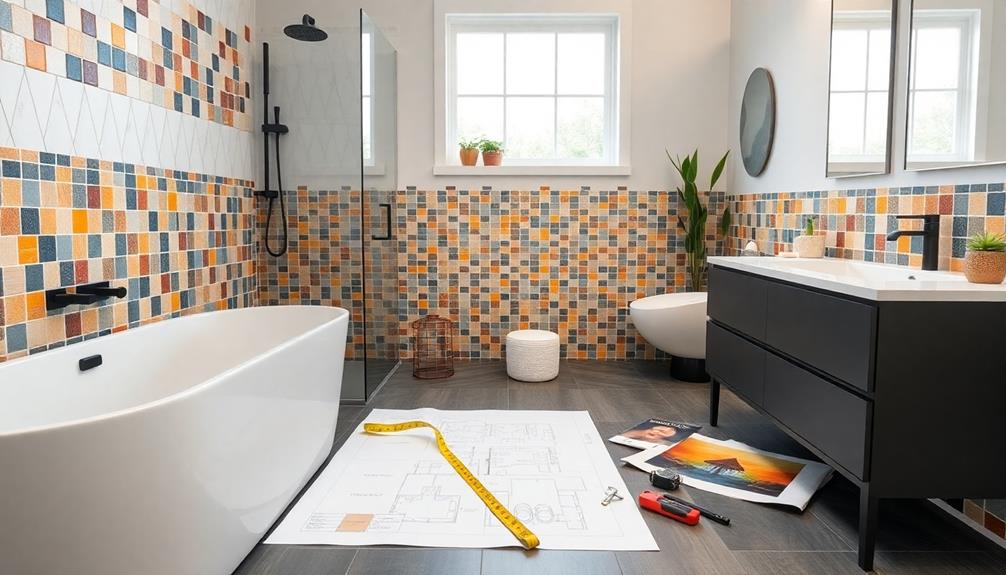To fix your sofa bed, start by assessing any damage, like broken frames or sagging mattresses. Gather the necessary tools, such as screws, wood glue, or metal brackets, depending on your frame's material. For wooden frames, apply glue to cracks and use clamps to secure them, while metal frames may require welding for severe breaks. Check the folding mechanism for debris or bent parts and lubricate moving components. To enhance comfort, consider adding a mattress topper. By following these steps, you can revive your sofa bed. There's more effective maintenance advice that can help you extend its life even further.
Key Takeaways
- Inspect the frame for cracks, misalignments, or broken mechanisms, and seek professional help for significant structural issues.
- Use wood glue for cracks in wooden frames, and reinforce weak areas with additional slats or metal mending plates.
- For metal frames, weld severe breaks and apply metal adhesive for minor cracks; replace any missing parts as needed.
- Regularly lubricate moving parts and tighten screws or bolts to ensure smooth operation of the sofa bed mechanism.
- Enhance comfort with a mattress topper and maintain the mattress by flipping, rotating, and vacuuming to prolong its lifespan.
Assessing the Damage
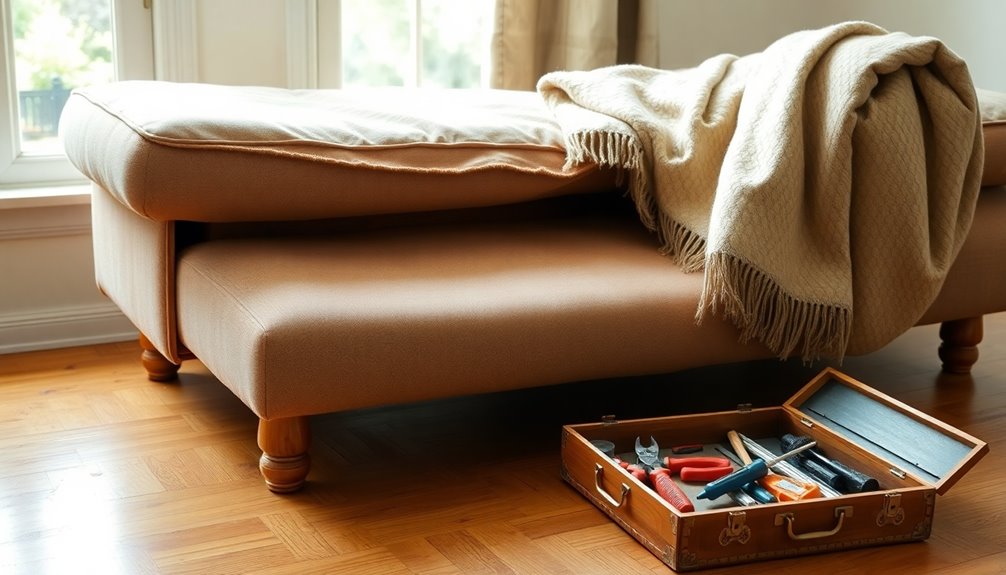
When you notice your sofa bed isn't functioning properly, it's essential to start by assessing the damage. Begin by locating the problem area on the frame. Common issues include cracked wooden slats, broken metal frames, or malfunctioning mechanisms. Check for sagging mattresses, which can stem from frequent use or inadequate support. Inspect the folding mechanism for any obstructions or misalignments, and look for bent parts, especially in the legs or folding mechanism.
Next, determine the material of the frame. Is it wood or metal? This affects your repair approach. Wood frames might have cracked slats or loose joints, while metal frames could show signs of bending. Understand the mattress support material too, like wooden slats or metal springs, and check for any black fabric decking that might be worn out. Additionally, it's important to evaluate structural integrity to ensure the frame can support weight post-repair.
Finally, evaluate the severity of the damage. Is the bend or break minor, or does it require intensive repair? Check for loose screws or bolts causing instability, and assess if the folding mechanism is jammed. Look for any signs of wear on both the frame and mattress to get a complete picture of the issue.
Tools and Materials Needed
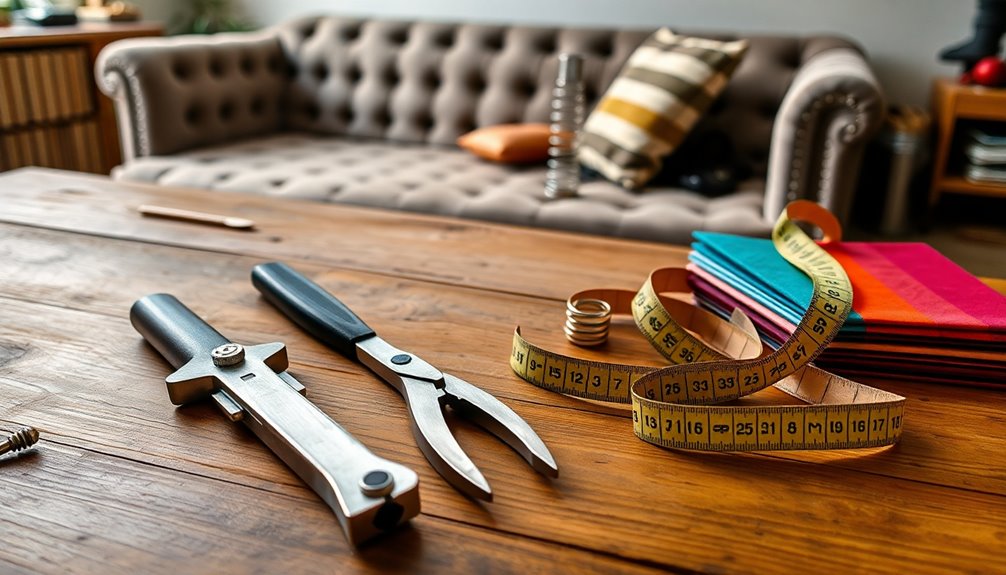
To effectively repair your sofa bed, you'll need a variety of tools and materials tailored to the specific issues you've identified. If you're dealing with metal frames, welding equipment is essential for severe breaks, along with metal brackets and screws. A drill will help you secure everything in place, while a rubber mallet or hammer can adjust any bent frames. Don't forget pliers or a vice grip for gripping and twisting.
For general frame repairs, stock up on screwdrivers, wrenches, and a staple gun. Wood glue is invaluable for reinforcing joints, and lubricant can help with any squeaky mechanisms. You might also need a Leather & Vinyl Complete Repair Kit for any minor damages to the upholstery. When tackling mechanisms and joints, keep light machine oil handy, along with bolts, screws, and replacement springs to ensure everything functions smoothly. For cushion and upholstery repairs, gather a needle and thread, a fabric repair kit, and fabric glue. Matching fabric for patches and high-density foam will restore comfort to those flat cushions.
With these tools and materials, you'll be well-equipped to get your sofa bed back in shape!
Repairing Wooden Frames
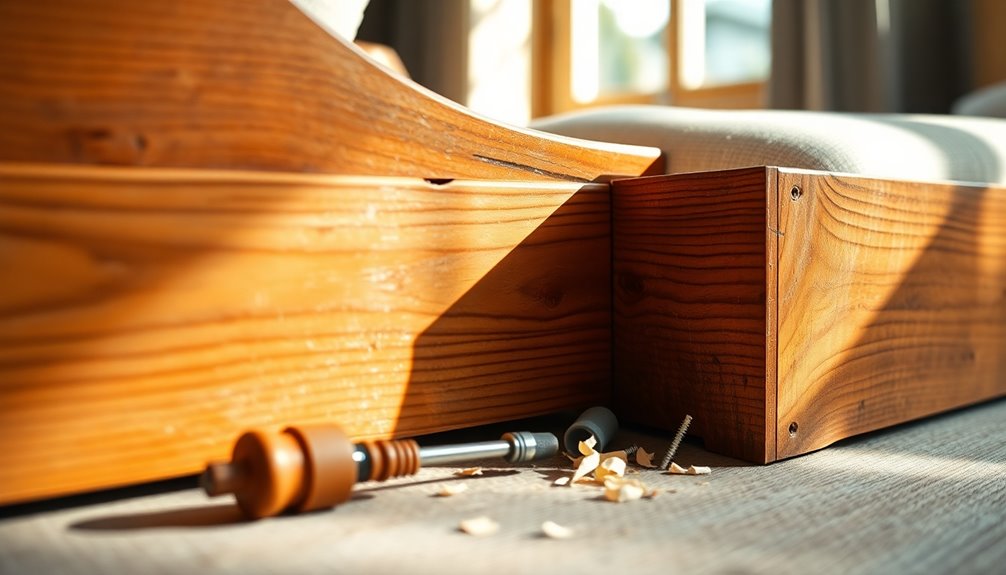
After gathering your tools and materials, it's time to focus on repairing wooden frames, which are common in many sofa beds. Start by assessing the damage. Locate any breaks or cracks in the frame and confirm that it's made of wood. Check for structural integrity, as well as any loose screws or bent parts.
For cracks, apply wood glue to fill them. Use clamps to hold the glued area tightly for about 24 hours, ensuring even pressure to prevent further damage. Once the glue dries, inspect the area for any remaining issues.
If you find broken slats, measure the damaged slat and cut a replacement piece to size. Secure the new slat in place with screws or nails, ensuring it's firmly attached to maintain stability.
To reinforce weak areas, consider adding extra support, such as additional slats or metal mending plates at stress points. Using metal brackets around bent areas provides extra stability. Reinforce joints with wood glue and additional screws. Finally, check that the sofa bed can still fold and unfold easily, and remember to carry out regular maintenance to prevent future issues, as regular maintenance tips can help prolong the lifespan of your sofa bed.
Repairing Metal Frames
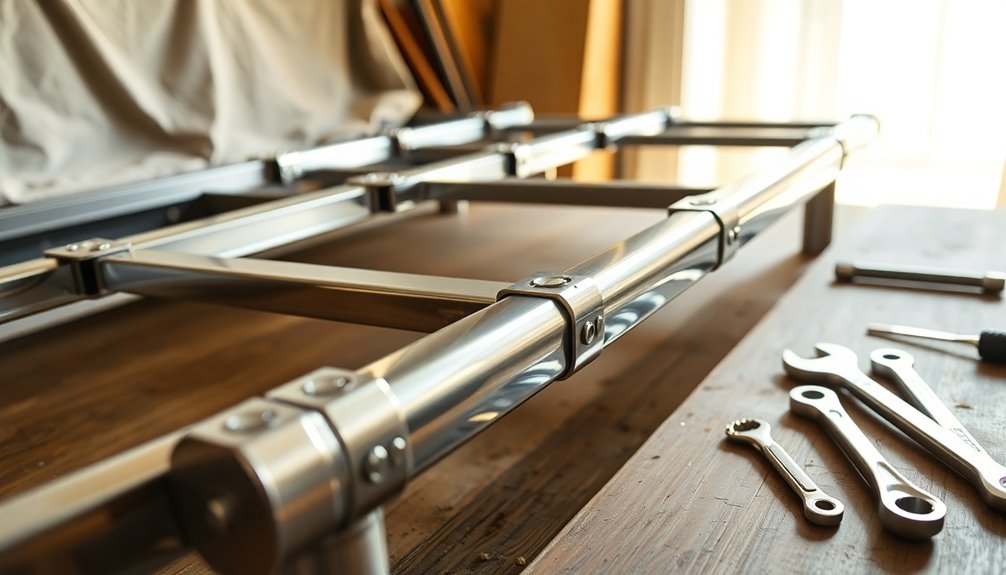
Many sofa beds feature metal frames that can face various types of damage over time. To start your repair, carefully examine the frame to identify the problem area. Check if it's a minor crack or a severe break; this will guide your repair approach. Make sure you determine the material of the frame, as it dictates your next steps. Look for loose connections, like screws or bolts, which may be contributing to the issue.
If you find severe breaks, welding might be necessary, ideally handled by a professional. For smaller breaks, consider using metal brackets. Secure them in place with screws to bridge the gap and add strength. If you encounter minor cracks, apply a metal-specific adhesive for a quick fix. Regular maintenance can prevent future loose connections from compromising the integrity of the frame.
Gather tools like a rubber mallet, pliers, and a metal file to aid your repairs. Once you've reinforced weak areas and ensured all fasteners are tight, check for any missing parts. Finally, test the functionality of the sofa bed to confirm that it folds and unfolds smoothly. With these steps, you'll keep your metal frame in good shape for years to come.
Fixing Bent Frames
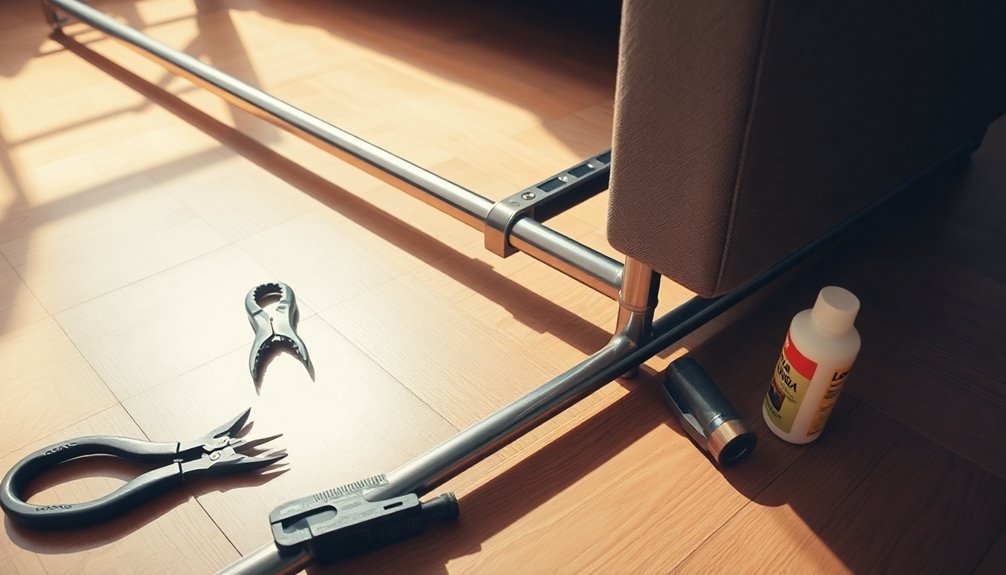
Even with a sturdy metal frame, sofa beds can develop bends over time, affecting their overall functionality. To start fixing this issue, locate the bend—common areas include the legs or the folding mechanism. Once you find it, determine its severity. Minor bends might be fixed with simple manual adjustments, while severe ones may require more intensive repair. Make sure there are no obstructions, such as debris or fabric, that could hinder the repair process.
Next, you can straighten the frame. Apply controlled force using a rubber mallet, tapping it gently while protecting the frame with wooden blocks. For smaller adjustments, pliers or a vice grip can help. If you're dealing with metal, applying heat cautiously can make it more malleable. It's also important to recognize that poorly made sofas may not be worth repairing, which can guide your decision-making.
After straightening, reinforce the area by adding support. Install extra slats or metal braces around the previously bent section. Tighten any loose screws or bolts to prevent future issues. Regularly inspect the frame for signs of bending or damage to catch problems early. With these steps, you can keep your sofa bed functioning effectively for years to come.
Solving Mechanism Issues
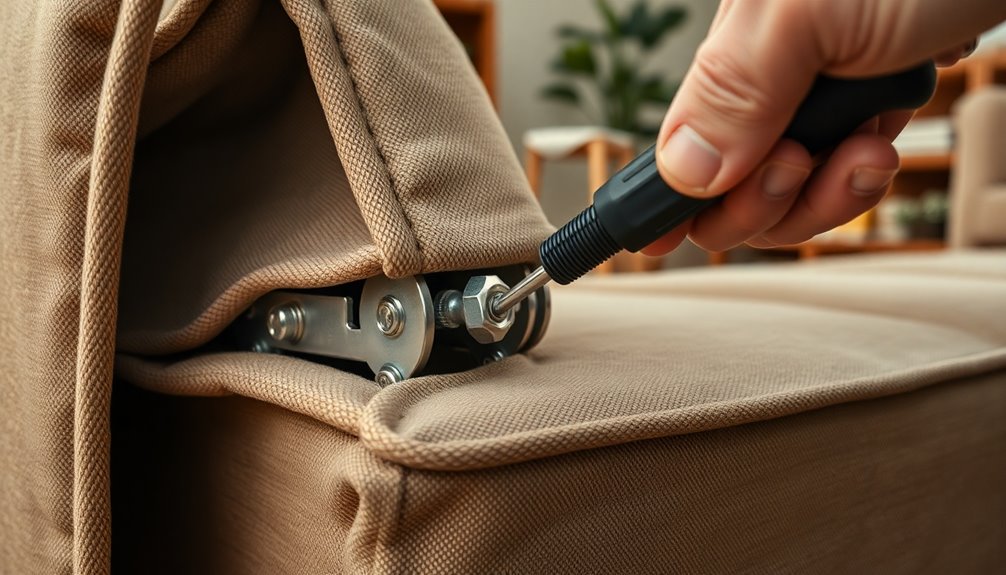
Sofa bed mechanisms can sometimes become a source of frustration when they get stuck or jammed. First, check for any debris or fabric obstruction within the mechanism and clear it out. Remove cushions, extra pillows, and bedding to ensure they aren't blocking the system. Inspect for bent parts or misalignments; if you find any, try to realign or fix them. If the problem persists, consider seeking professional support.
If you notice broken springs or hinges, identify the faulty parts and replace them with new ones from a furniture repair shop. Compare each side of the mechanism to spot discrepancies and replace any sheared-off rivets or bolts. Ensure you're using the right size and type of springs as specified by the manufacturer.
Regular lubrication and maintenance can prevent many issues. Apply light machine oil to every moving part to ensure smooth operation, and tighten any loose screws or bolts to reduce friction. Additionally, performing regular checks on the sofa bed mechanism can help catch problems before they escalate. Lastly, adjust bolts and screws to ensure the mechanism opens and closes smoothly. Test it several times after making adjustments to confirm everything's functioning correctly.
Addressing Comfort and Sagging
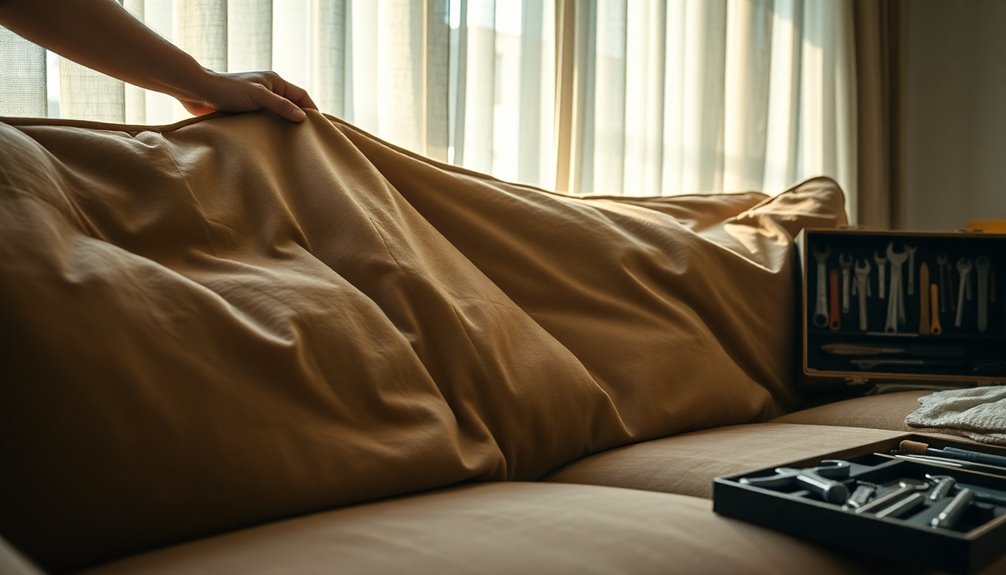
When your sofa bed starts to feel uncomfortable or shows signs of sagging, addressing these issues promptly can enhance your sitting and sleeping experience. One effective way to boost comfort is by adding a mattress topper. A memory foam or gel-infused topper can provide additional support and warmth, particularly beneficial for side sleepers. Make sure to choose a thickness that suits your needs without causing discomfort. Additionally, sofa beds are designed for dual-purpose use, which means they often sacrifice comfort compared to traditional beds.
Next, invest in high-quality bedding. Selecting breathable, soft linens can significantly improve your comfort while ensuring they match your sofa bed's design. Additionally, utilize pillows and cushions for extra support. Experiment with different arrangements to find what feels best, and consider memory foam pillows for better spinal alignment.
To combat sagging, reinforce the frame or add plywood beneath the cushions for support. If the mattress has noticeable sags, a topper can help cover those imperfections. Regular cleaning and maintenance are crucial too—flip and rotate the mattress every few months, vacuum regularly, and change sheets often. These steps not only enhance comfort but also extend the life of your sofa bed, ensuring it remains a cozy retreat.
Preventive Maintenance Tips
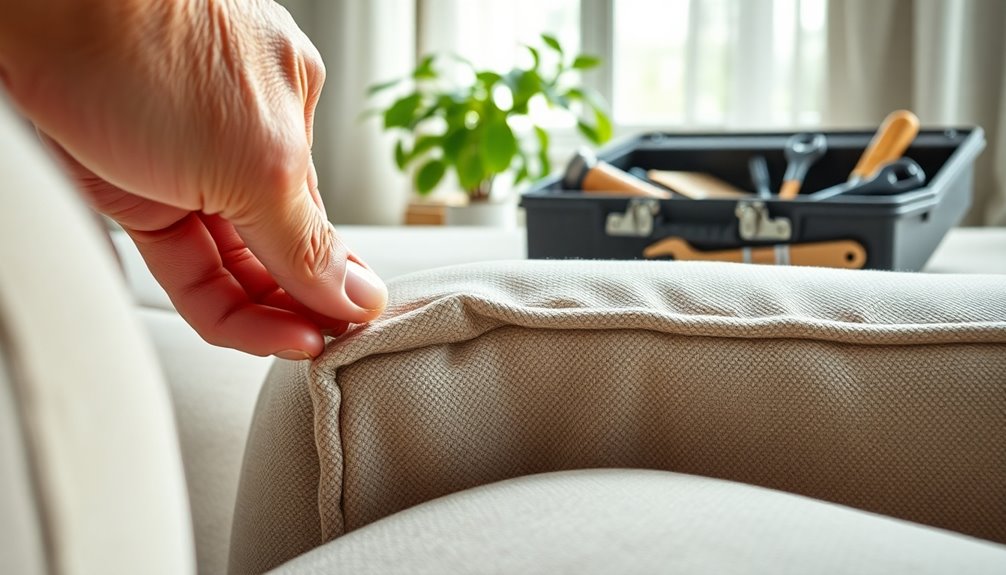
To keep your sofa bed in great shape, regular preventive maintenance is essential. Start by vacuuming the surface weekly with an upholstery attachment to eliminate dust, crumbs, and debris. Don't let spills linger; treat stains promptly with a mild detergent and water solution or a specialized cleaner. Rotate and fluff your cushions regularly to ensure even wear and maintain their shape.
For deeper cleaning, consider steam cleaning fabric sofa beds once or twice a year. If you have a leather sofa bed, use a leather cleaner and conditioner to keep it supple and shiny. Remember to air out or wash removable mattress covers to maintain a clean sleeping surface. When steam cleaning fabric sofa beds, make sure to test a small, inconspicuous area first to ensure that it doesn’t damage the fabric. Additionally, be sure to vacuum the sofa bed thoroughly before steam cleaning to remove any loose dirt and debris. For more fabric sofa cleaning tips, consult the manufacturer’s recommendations or seek advice from a professional upholstery cleaner. It’s important to keep your sofa bed clean not only for appearance sake, but also for the health and comfort of anyone who uses it.
Protect your sofa bed with furniture protectors or slipcovers to guard against spills and pet hair. Keep sharp objects away to prevent damage, and ensure it's safe for pets and children by securing loose parts. Regularly inspect the frame for any signs of warping or damage. Lastly, if you store your sofa bed, clean it thoroughly and use breathable bags for cushions and bedding to prevent moisture build-up. Following these tips will help extend the life of your sofa bed, as regular cleaning is crucial for prolonging the lifespan of the sofa bed.
When to Seek Professional Help
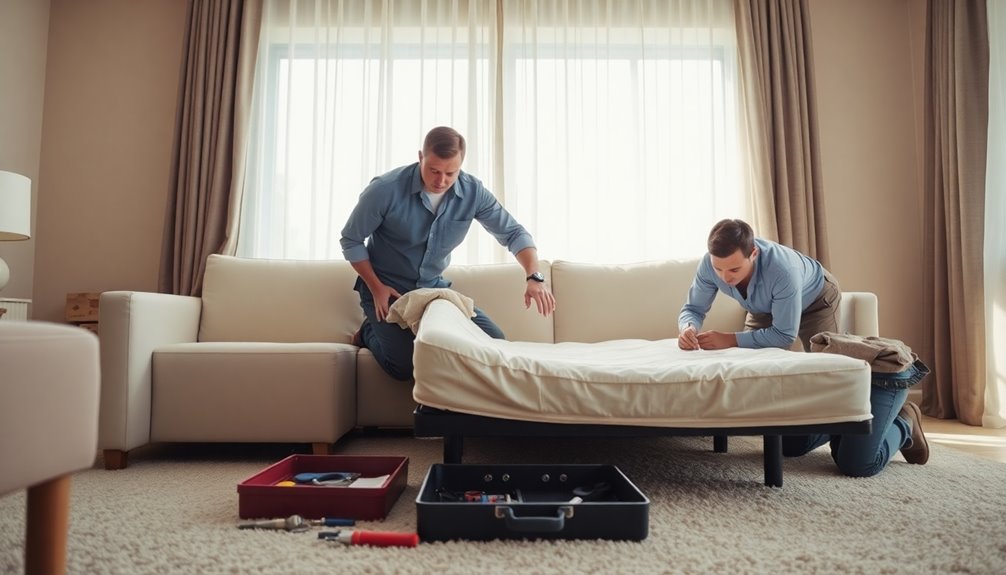
Recognizing the right moment to seek professional help can save you time and prevent further damage to your sofa bed. If you notice frame damage or any issues affecting its structural integrity, don't hesitate to call in an expert. Broken mechanisms and limitations in adjustments often require specialized knowledge to fix. Similarly, if you face complex repairs that involve tools you don't have, it's best to seek professional support.
When it comes to upholstery, stubborn stains that won't budge with home cleaning methods signal the need for a professional touch. Worn-out upholstery or significant fabric tears also warrant expert attention. If your sofa bed is battling allergens or mold, professional cleaning is crucial for health reasons. Additionally, if you experience metal bars causing discomfort while using your sofa bed, it may be time to consult a professional for repair or replacement.
Comfort issues like inadequate cushions or sagging springs indicate it's time for a professional assessment. Mattress replacements, especially those that require high-quality materials, should also be handled by experts. Lastly, consider professional help for deep cleaning, inspections, or custom modifications. They can enhance both comfort and lifespan, ensuring your sofa bed serves you well for years to come.
Frequently Asked Questions
Can I Use Regular Glue for Wooden Repairs?
You can't use just any regular glue for wooden repairs. It's important to choose a wood-specific adhesive like PVA glue, which provides a strong bond and is easy to clean up. Regular glue may not hold up under stress or may not adhere well to wood surfaces. For durability and effectiveness, select a glue designed for wood that suits your project's needs and offers the strength required for a lasting fix.
How Do I Know if a Mattress Is Too Thick?
To know if a mattress is too thick for you, consider your sleeping position and body weight. If you're a side sleeper, a thickness of at least 12 inches is ideal for pressure relief. For back sleepers, 10-12 inches works best. If you find it hard to sink into the mattress or experience discomfort, it might be too thick. Also, check if you need deep-pocket sheets for proper fit.
What Type of Wood Is Best for Replacement Slats?
When you're choosing wood for replacement slats, hardwoods like oak or beech are great options due to their durability and resistance to warping. If you prefer something lighter and more affordable, consider softwoods like pine or spruce. Each type has its benefits, with hardwoods providing long-lasting support and softwoods offering flexibility. Ensure the slats are at least 3-4 inches thick for optimal strength, and keep a gap of 2 to 2.75 inches between them.
Are There Specific Tools for Repairing Sofa Bed Mechanisms?
Yes, there are specific tools for repairing mechanisms. You'll need screwdrivers to tighten screws and adjust parts, pliers for gripping metal, and wrenches for bolts. Lubricant keeps moving parts smooth, while a rubber mallet helps adjust bent frames without damage. If you encounter severe metal breaks, welding equipment and metal braces will be crucial. Having these tools on hand will make your repair process much smoother and more efficient.
How Often Should I Perform Preventive Maintenance?
You should perform preventive maintenance on your sofa bed regularly to keep it in top shape. Daily tasks like vacuuming and fluffing cushions help maintain its appearance and comfort. Weekly, focus on deep cleaning and inspecting for damage. Monthly, take time for a thorough clean and air out the mattress. Annually, consider professional cleaning and check the mechanisms. By sticking to this schedule, you'll prolong the life of your sofa bed significantly.
Conclusion
Fixing your sofa bed doesn't have to be overwhelming. By assessing the damage, using the right tools, and following the repair steps for both wooden and metal frames, you can restore its functionality and comfort. Don't forget to keep up with preventive maintenance to prolong its life. If you find the damage too extensive or the mechanisms too complicated, it's okay to reach out to a professional for help. Your sofa bed will thank you!
